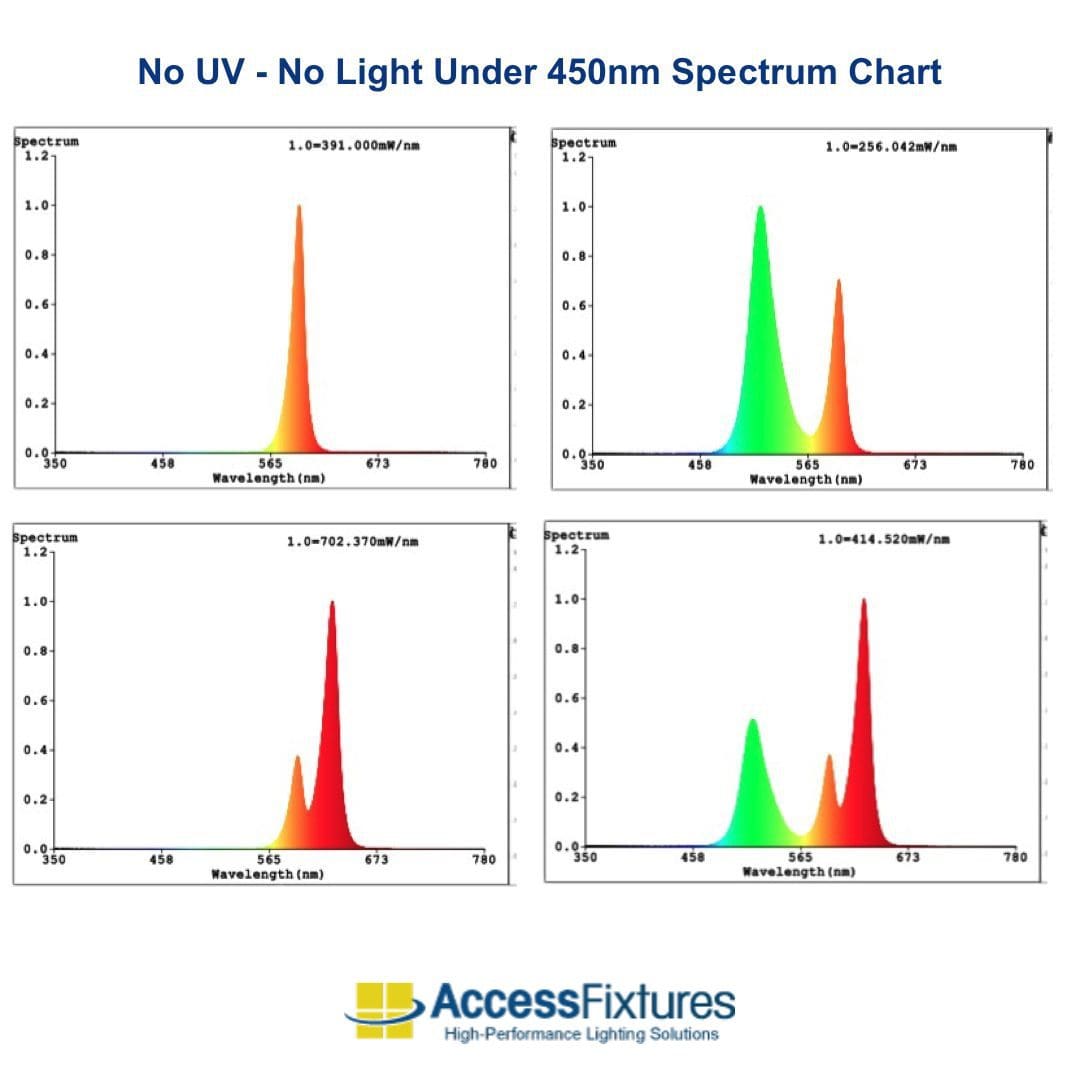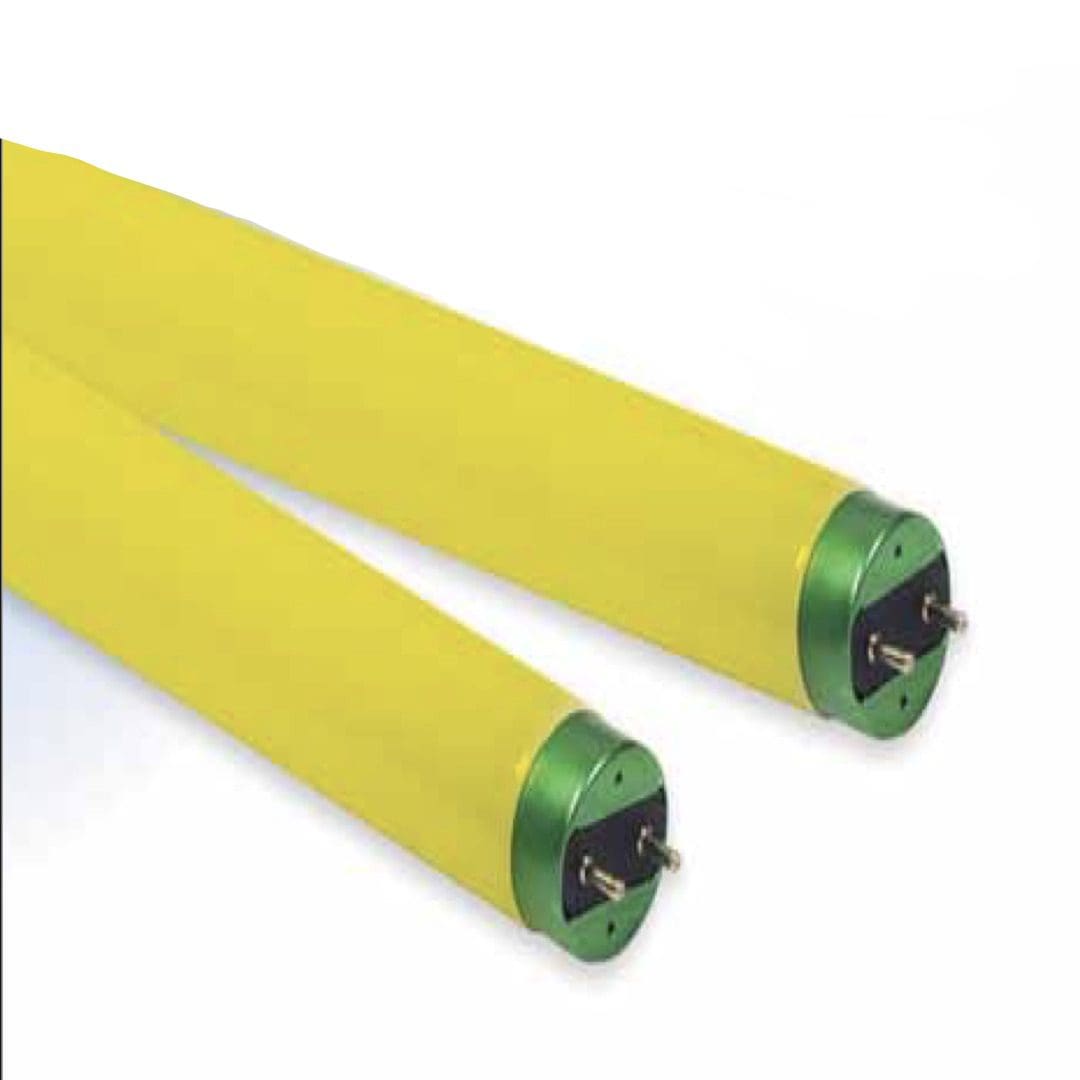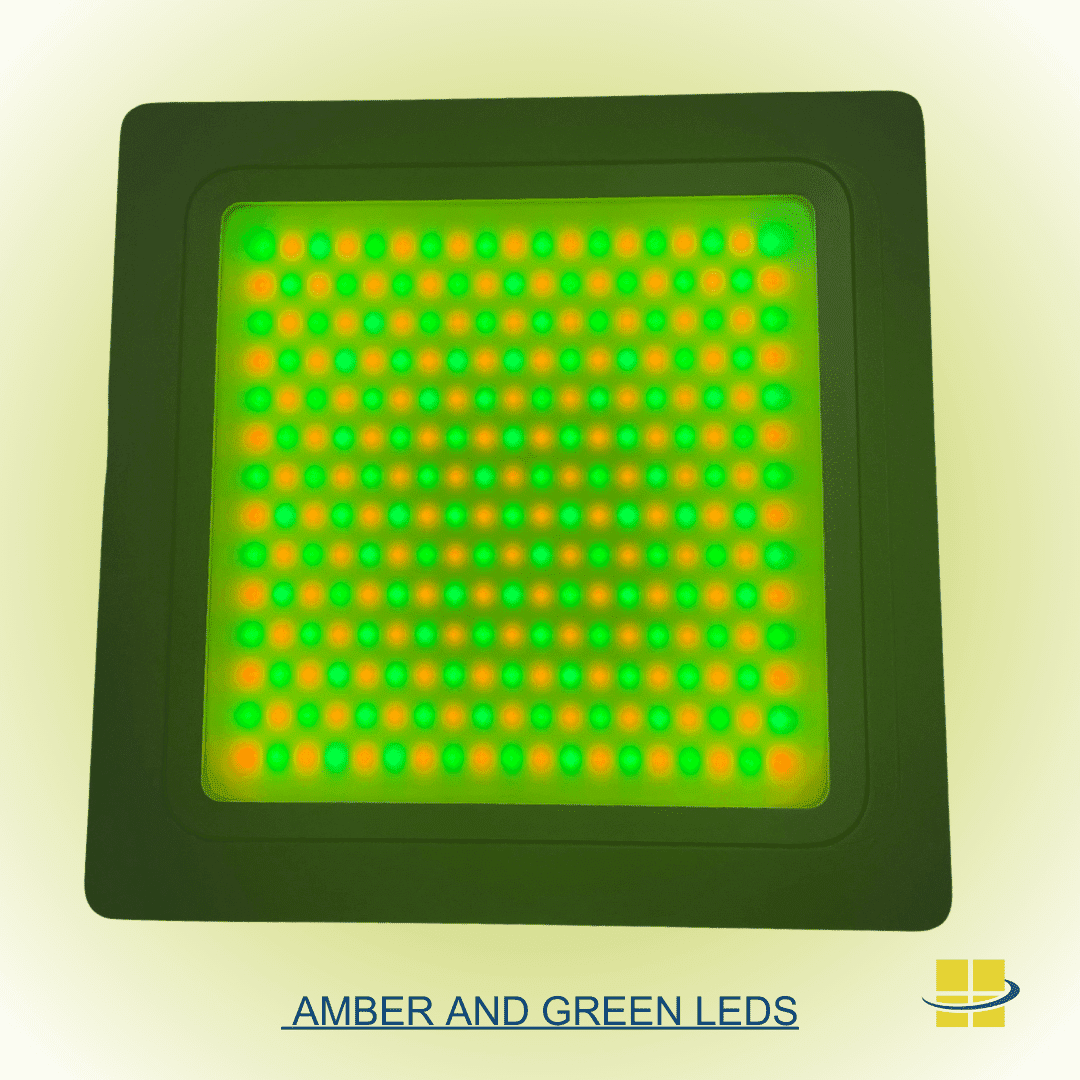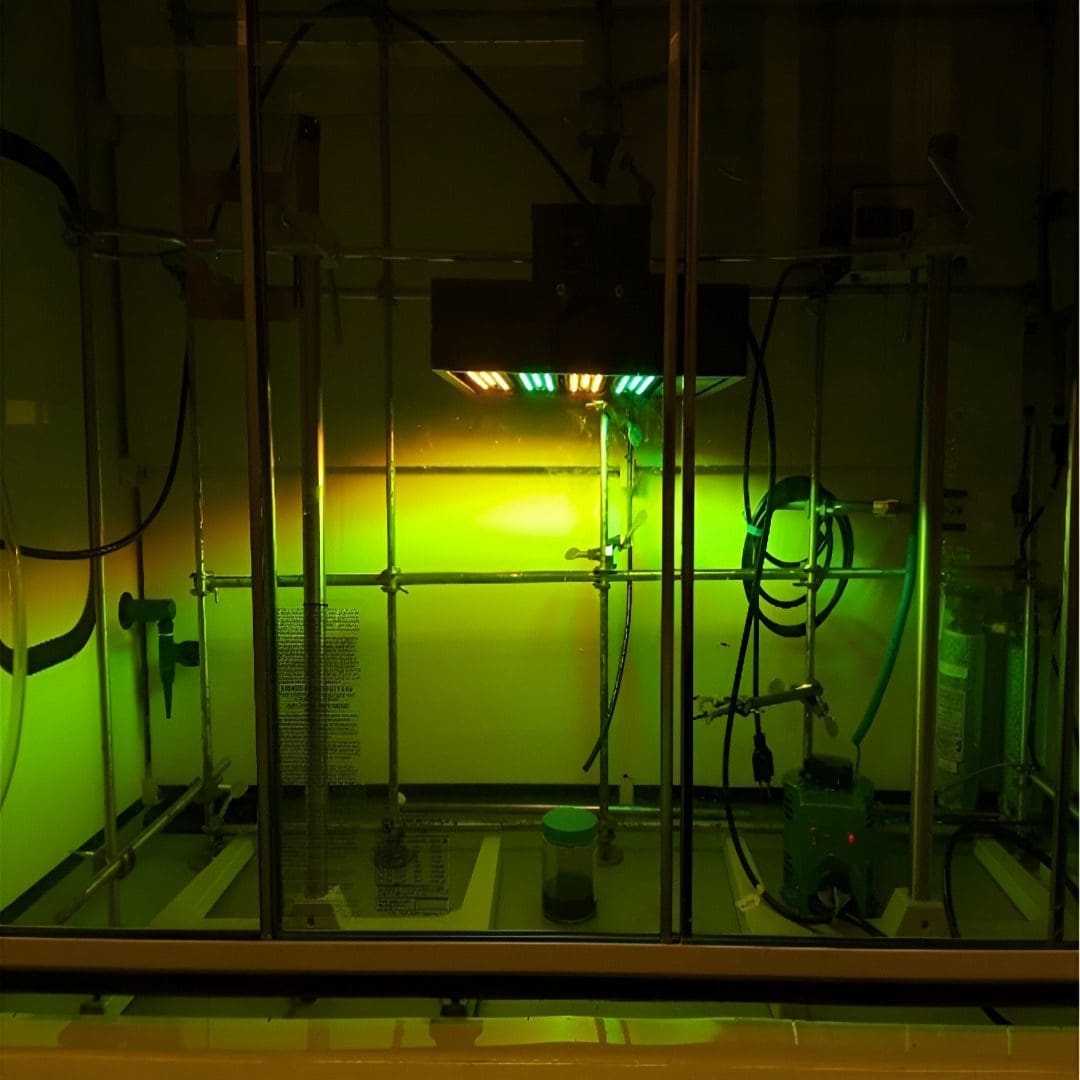
Ultraviolet light (UV) is used in the manufacturing process of many products. Typically, UV used for manufacturing or processing is for UV curing. Manufacturing processes that use UV for curing require an environment that has no UV light. If there is UV in the light, it will start a chemical change that will degrade the product being manufactured. To prevent UV light from being emitted, sunlight is blocked, and UV block light filters such as UV Block fluorescent tube guards, UV block coatings, and UV block filters are used to stop all UV light. In this article we will answer the question: Are UV-blocking fluorescent tube guards obsolete? Are UV block filters and coatings obsolete, and what are the alternatives to UV-blocking fluorescent tube guards and filters?
Key Takeaways
-
- Obsolete Technology: UV-blocking fluorescent tube guards and filters are outdated due to their narrow light spectrum, degradation over time, and poor visibility.
- Superior LED Performance: Access Fixtures’ No UV LED lights provide consistent, flicker-free, and broad-spectrum illumination with minimal maintenance and no UV emissions.
- Enhanced Efficiency: No UV LEDs offer better reliability, higher wattage options, compact designs, and are mercury-free, making them safer and more cost-effective than fluorescent lights.
Which Manufacturing Processes Utilize UV Curing?
This is a partial list of manufacturing processes that utilize UV curing.
- Electronics Manufacturing: UV light is used for curing adhesives, encapsulants, and coatings in the production of electronic components, circuit boards, EPROMs (erasable programmable read-only memory), and microprocessors.
- Medical Devices: UV light is to cure plastics and silicon materials used in or to make medical devices. An example is polymer- or silicone-hydrogels used to make contact lenses.
- Photolithography: The semiconductor industry uses UV light in photolithography processes for manufacturing integrated circuits and other microelectronic devices.
- Coatings and Finishes: UV curing is utilized in the application of coatings and finishes for products such as furniture, automotive parts, and wood flooring, providing rapid curing and enhanced durability.
- Graphic Arts: UV curing is utilized in the production of signage, labels, and packaging materials for its ability to produce vibrant colors and quick drying times.
- Dental Industry: UV light is used in the curing of dental composites and adhesives during dental restoration procedures.
Keeping UV Sensitive Materials Light Away from UV Light
In a manufacturing process that utilizes UV curing, exposure to daylight or artificial light that has UV can potentially degrade the product being manufactured. This degradation occurs because daylight and most artificial light contains UV light. When these materials are exposed to daylight or artificial light for extended periods, the UV light can cause photochemical reactions that lead to degradation. This degradation may manifest as changes in color, loss of mechanical strength, reduced adhesion, or alterations in other physical or chemical properties of the product, compromising the quality and performance of the manufactured items. To mitigate the impact of daylight exposure on products undergoing UV curing, manufacturers often implement measures such as using UV-blocking materials or filter limiting.
Understanding UV Light
UV light, or ultraviolet light, is a form of electromagnetic radiation that is invisible to the human eye. It occupies a space on the electromagnetic spectrum between visible light and X-rays. UV light has wavelengths shorter than visible light but longer than X-rays. This specific positioning gives UV light its unique properties and effects on various materials and processes.
Wavelengths and Manufacturing Processes: In the context of manufacturing processes, UV light is generally considered to be any light with wavelengths below 450 nanometers (nm). Light above this threshold typically does not interfere with manufacturing processes. While light between 450nm and 420nm is less likely to impact these processes, engineers and scientists often set a strict threshold at no light below 450nm to ensure an adequate margin of error. This precaution helps maintain the integrity of manufacturing environments, especially those sensitive to UV light.
Impact of Sunlight and Artificial Light: In production areas requiring no UV light, it is essential to block sunlight, as it naturally contains UV radiation. Additionally, many types of artificial lighting, including fluorescent lights, metal halide lights, and high-pressure sodium (HPS) lights, emit UV light. While metal halide and HPS lights are seldom used in UV-sensitive production facilities due to their high UV emissions, fluorescent lights are more common. However, to mitigate their UV output, fluorescent lights in these environments are often equipped with UV-blocking fluorescent tube guards or UV filters. These filters are placed between the fluorescent bulbs and the polycarbonate lens of the light fixture, effectively blocking UV radiation and protecting the manufacturing process from potential degradation.
Using UV Blocking Fluorescent Tube Guards, Coatings, and Filters
UV blocking fluorescent tube guards and UV blocking coatings, sometimes called gold tubes, gold coatings, or gold lamps, have been a viable solution to filter out UV light below 450nm. These guards are specifically designed to filter out UV radiation while allowing visible light to pass through, thereby providing enhanced protection.
Problems with UV Blocking Tube Guards, Coatings, and Filters
They Only Produce a Very Narrow Spectrum of Light
This narrow spectrum results in a flat yellow cast which is unpleasant to work under and allows for almost no color rendering. Color rendering can be an important factor in clean rooms and production facilities and a yellow cast results in poor visibility that employees consistently complain about.
UV Blocking Tube Guards, Coatings, and Filters Crack and Flake
Heat is the enemy of UV Blocking Tube Guards, Coatings, and Filters and light bulbs produce heat. Over time the materials used for UV Blocking Tube Guards, Coatings, and Filters break down causing UV light to escape. This can cause the production taking place to be compromised or the production run to be lost.
UV Blocking Tube Guards, Coatings, and Filters Breakdown
Similar to the cracking and flaking problem, heat changes the chemical compounds that filter UV light out. UV light passes through the compromised filter putting the manufacturing and processing at risk.
Access Fixtures No UV LED Lights – No Light Under 450nm Never Emit UV
Access Fixtures No UV Lights – No Light Under 450nm use LEDs that emit a fixed spectrum of light that will never change removing the threat of compromised production.
No-UV LED Lighting vs. No-UV Filtered Fluorescent .pdf
No UV Light and No Compromise
The next generation of No UV lighting is available today at Access Fixtures, and it is achieved without the use of UV-blocking tubes or filters.
More broad-spectrum light
Instead of one very narrow band off the light spectrum, there are 4 choices of light spectrum, an equivalent one, and 3 which are more broad spectrum. Broad spectrum light provides and more normal work environment and happier more productive employees.
Smaller Light Fixtures
Space is tight in clean room ceilings and in other specialty production facilities. LED lighting reduces the area required for the light fixture by 50% or more making it easier to have more light emitted or providing more space for other equipment in the ceiling.
More Watts for More Light
OSHA requires certain production areas to maintain a minimum amount of footcandles on the work surface. Production facilities need employees to see what they are working on. Fluorescent lighting requires a large area for light and most fixtures max out at 324 watts. Access Fixtures No UV lights are available in up to 2400 watts with a smaller form factor.
Directed Light
Fluorescent light is emitted 360° making the light distribution undirected and limiting the distance that the light can travel. No UV LED light fixtures direct the light to where it is needed creating far more energy efficiency, while advanced optics can facilitate the light traveling a greater distance. The latter is very important for facilities with high ceilings.
More Form Factors
Fluorescent lights are limited by the large size of fluorescent light bulbs. No UV LED light fixtures can be produced in many form factors including linear light fixtures and small light fixtures.
Flicker Free
Fluorescent lights flicker, while No UV LED lights do not flicker.
Less Maintenance and Lower Maintenance Expense
No UV LED lights require low to no maintenance as compared to fluorescent lights, and that means more production time and lower cost. Fluorescent light bulbs last 20,000 to 24,000 hours depending on the technology. The filters may or may not last that long. No UV LED lights are L70 @ 70,000 hours and No UV LED lights do not have filters that eventually fail.
Dimmable
Fluorescent lights with UV blocking tube guards may have dimming ballasts, but they are expensive and kludgy. No UV LED lights use 0-10v dimming with either a wired low-voltage switch or a wireless dimmer control.
Infinite On-Off Cycles
Unless equipped with programmed start technology, fluorescent light bulbs have cathodes that degrade with on-off cycles reducing the life of the fluorescent lamp. Programmed start extends the life of the cathodes. No UV LED lights can handle infinite on-off cycles and are even flashable.
No Mercury
Mercury is a hazard in any workplace and has increased risk when introduced to medical devices. Most states have laws that require lamps with mercury to be recycled, and that is costly. Fluorescent lights have Mercury that is distributed through the workplace if a light bulb breaks. No UV LED lights do not contain Mercury.
No Compromised Production Runs
When a filter fails, the production run is compromised, and the entire production run might need to be scrapped. That is expensive. No UV LED lights never emit UV light and they don’t emit UV light.
Conclusion: UV Blocking Fluorescent Tube Guards Are Obsolete
UV Blocking Fluorescent Tube Guards are obsolete. No UV LED light fixtures from Access Fixtures have all the benefits of LED lighting and none of the negatives of fluorescent lighting. Also, No UV LED lights do not rely on filters that will break down compromising expensive production runs. Going forward new facilities that require No UV lighting will be built with No UV LED lighting and existing facilities will be retrofitted with No UV LED light fixtures. Learn more about The Future of No UV LED Lighting here.
UV Blocking Fluorescent Tube Guard FAQs:
You have No-UV LED Lighting questions. We have answers. If you have a question that isn’t answered below, contact an Access Fixtures lighting specialist at (800) 468-9925 or visit our customer service page.
Can UV blocking guards be installed on existing fluorescent fixtures?
Yes, many UV blocking guards are designed for placement over fluorescent light bulbs. The UV blocking tubes slide over the fluorescent light bulb. Be careful when installing a fluorescent lamp in a UV blocking tube. If the light bulb slides out of the tube and breaks, the workplace will have Mercury contamination.
Do UV blocking guards affect the brightness of fluorescent lights?
UV blocking tube guard manufacturers claim that there is minimal light loss.
Do UV blocking guards and UV block filters affect the color temperature of fluorescent lighting?
Yes. To block UV light, UV blocking tube guards and UV block filters block most of the light spectrum leaving some light only around 590nm, which is an amber colored light. It doesn’t matter what Kelvin fluorescent light bulbs are used. The light emitted with UV blocking tube guards or filters is a narrow spectrum amber.
What is the typical lifespan of UV blocking fluorescent tube guards?
The general claim is the lifespan of UV blocking fluorescent tube guards varies depending on factors such as usage, environment, and maintenance. Some companies claim the UV blocking tube guards or filters last as long as the fluorescent lamp. It’s risky to wait too long to replace the tubes or filters. When the filter fails to block UV light, the production run fails.
Are UV blocking tube guards and fluorescent lamps with UV block coatings recyclable?
Recycling options may vary depending on local regulations and facilities. Fluorescent light bulbs are typically recyclable, and by law may need to be recycled, but it’s not that simple. Small quantities need to be specially packaged and shipped to a recycling facility. Large quantities such as a gaylord or more may be picked up by a local recycler if one exists. Fluorescent lamps coated with UV block filter material may not be accepted at many recycling facilities or the recycling cost may be higher.
Speak to an Access Fixtures Lighting Specialist About No UV LED Light Fixtures
Access Fixtures prides itself on using high-quality components to provide reliable LED lighting solutions. Whether you need LED sports lighting, LED high bays, LED bollard lights, or another kind of lighting altogether, Access Fixtures has the resources to get you the solution you’re looking for. Do you need to discuss a unique lighting project or how to upgrade your obsolete UV Blocking Fluorescent Tube Guards to No UV LED Light Fixtures? Talk with an Access Fixtures lighting specialist by phone at 800-468-9925 or by email at [email protected] today.





